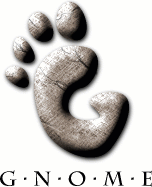36 GNOME: The Desktop
20231021

GNOME is a desktop platform for Unix and GNU/Linux, delivering a high level of usability through consistency of application interfaces, as well as interoperability. The GNOME Foundation, initiated in August 2000, brought together many of the major Unix vendors of the time, including Sun Microsystems, IBM, HP and Compaq, to support the further development of GNOME. Sun (later acquired by Oracle), for example, identified the GNOME desktop as the standard for Solaris, one of the most popular commercial versions of Unix at the time.
GNOME, an abbreviation for the GNU Network Object Model Environment
and is a component-based system built around standards such as XML and
CORBA. It offers a standard look-and-feel for applications and a
platform for applications to share resources.
While GNOME applications share the same look-and-feel, you can
choose the theme for that look-and-feel to suit your own style. Many
themes are available including those that mimic other operating
systems (MS/Windows and Mac/OSX). Once you choose a theme all of the
GNOME applications will use that theme immediately. You can change
themes at any time through the gnome-tweak tool. We use
different themes through this book, noting that our preferences may
change over time. Themes used include Ambiance and themse may
be chosen with a lighter grey in the background to suit screenshots to
be used in publications.
Your donation will support ongoing availability and give you access to the PDF version of this book. Desktop Survival Guides include Data Science, GNU/Linux, and MLHub. Books available on Amazon include Data Mining with Rattle and Essentials of Data Science. Popular open source software includes rattle, wajig, and mlhub. Hosted by Togaware, a pioneer of free and open source software since 1984. Copyright © 1995-2022 Graham.Williams@togaware.com Creative Commons Attribution-ShareAlike 4.0
